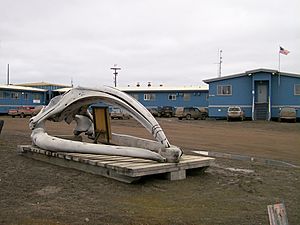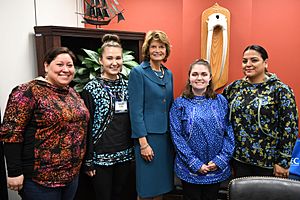Iḷisaġvik College facts for kids
 |
|
| Motto | Honoring your past, preparing for your future |
|---|---|
| Type | Public tribal land-grant community college |
| Established | 1996 |
|
Parent institution
|
North Slope Borough |
|
Academic affiliations
|
UArctic; AIHEC |
| President | Justina Wilhelm |
| Location |
,
,
United States
|
| Campus | Rural |
Iḷisaġvik College (pronounced i-li-SAH-gvik) is a special kind of college in Utqiaġvik, Alaska. It's a public college that serves the Iñupiat people. It's the only tribal college in Alaska. It's also the northernmost college in the United States!
The college is in the Alaska North Slope, a huge area of Arctic land. This area is mostly tundra, which is a flat, treeless plain. You can reach the college by plane. In winter, there's even an ice road for locals.
Iḷisaġvik College is part of the American Indian Higher Education Consortium. It offers different types of education. Students can earn a bachelor's degree in business. They can also get associate's degrees or one-year certificates. The college helps adults prepare for their GED tests too. In 2020, their dental therapy program became the first in the U.S. to be fully approved.
Contents
College History

Iḷisaġvik College got its current name in 2005. It started as a partnership with the University of Alaska Fairbanks in 1986. This college was created because Native American and Alaskan Native people wanted more control over their own education and culture. This movement grew in the late 1960s and early 1970s.
The North Slope Borough, which is the local government for the Iñupiat people, was formed in 1972. This was a big step for the Iñupiat to regain control of their culture. The college was made to help Alaskan Natives and American Indians get higher education. It especially helps people in faraway places who might not have other ways to go to college.
In 1995, the Borough officially made Iḷisaġvik College an independent, non-profit school. The college moved into a building that used to be a U.S. Naval Arctic Research Laboratory. In 1996, the college also took over the Iñupiat Heritage Center. For a short time in 1997, the school was called Arctic Sivunmun Iḷisaġvik College.
From 1995 to 2005, the college was led by Edna Ahgeak MacLean. She was an educator from Utqiaġvik. In 1997, Iḷisaġvik College helped start the Consortium for Alaska Native Higher Education (CANHE).
In 2005, the North Slope Borough officially established Iḷisaġvik College. It was the first, and is still the only, tribal college in Alaska. In 2007, the U.S. government recognized it as the 36th tribal college. The next year, it was named a land-grant college. This means it gets federal support to teach practical subjects like agriculture and engineering.
College Presidents
Iḷisaġvik College has mostly been led by Native educators. Many of them are local Iñupiat people.

| S. No. | Name | Term |
|---|---|---|
| 1. | Benjamin Nageak (executive vice president) | |
| 2. | Edna Ahgeak MacLean | 1995–2005 |
| 3. | Beverly Patkotak Grinage | 2005–2010 |
| 4. | Brooke Gondara | 2010–2011 |
| 5. | Pearl Kiyawn Nageak Brower | 2012–2020 |
| 6. | Justina Wilhelm | 2020–present |
What Students Learn
| Race and ethnicity | Total | |
|---|---|---|
| American Indian/Alaska Native | 70% |
|
| Native Hawaiian/Pacific Islander | 10% |
|
| Asian | 9% |
|
| White | 8% |
|
| Black | 1% |
|
| Hispanic | 1% |
|
| Two or more races | 1% |
|
| Unknown | 1% |
|
The college was approved in 2003 by the Northwest Commission on Colleges and Universities. This means its programs meet high standards. Students can earn a bachelor's degree in business. They can also get associate's degrees or one-year certificates. The college helps adults prepare for their GED tests too.
The programs at Iḷisaġvik College include Iñupiat traditions and values. They also help students get ready for jobs and careers. In 2018, the college hoped to add a second bachelor's degree program. This new program would focus on elementary education with an indigenous (Native) focus.
In 2020, the college's Alaska Dental Therapy Educational Program became the first in the U.S. to be fully approved. This program started in 2004. By 2017, it had helped provide dental care to 40,000 more people. Most of these people lived in rural areas across Alaska.
College Partnerships
Iḷisaġvik College is a member of the American Indian Higher Education Consortium (AIHEC). This group helps tribal colleges work together. They aim to make tribal communities stronger through higher education.
The college is also an active member of the University of the Arctic (UArctic). UArctic is a group of over 200 universities and organizations. They work together to promote education and research in the Arctic region.
How the College is Run
Iḷisaġvik College is supported by the Inupiat Community of the Arctic Slope (ICAS) tribal government. The college includes Iñupiaq values in everything it does. They believe these values make students and the college community stronger. By staying true to the Iñupiat culture, Iḷisaġvik helps strengthen the language and traditions. It also helps students prepare for jobs in today's world. The college wants its graduates to use their traditional values in modern life.
College Campus
The college library is called the Tuzzy Consortium Library. It is named after Evelyn Tuzroyluk Higbee. She was one of the first people on the college's Board of Higher Education. The campus is located in the buildings that used to be the Naval Arctic Research Laboratory.
See also

